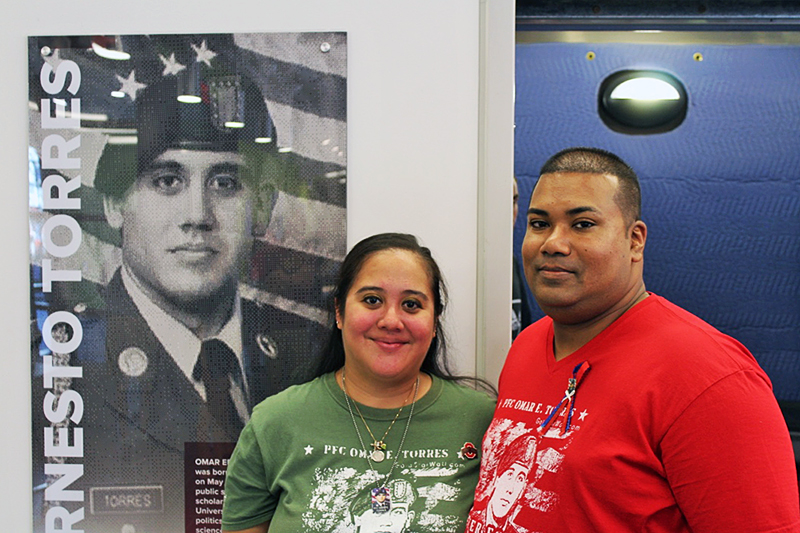
Oralia, Omar’s sister and Sam, Oralia’s husband pose in front of a photo of Omar Ernesto Torres in Torres House on August 22 in Columbus, Ohio. Photo Credit: Michael Huson / Campus Editor
After incoming students were met by rows of cheering student volunteers outside their residence halls on move-in day, students stepped into their new home at Torres House. They were then met with the inspirational words of a fellow Buckeye.
“Never stop,” reads a portion of an essay written by Omar Ernesto Torres that hangs within a shadowbox frame in the lobby, along with his Army uniform.
Torres was killed at age 20 during combat operations in Iraq on Aug. 22, 2007 – exactly eight years to the day of Ohio State’s official move-in date.
The new residence hall at 187 W. Lane Ave is named in his memory.
Oralia Torres, Omar’s sister, arrived early to the house opening on Saturday with her husband, three-month old son, Torres’ older brother Oscar, and his wife and two sons.
“It’s amazing and it’s bittersweet at the same time,” she said of the residence hall’s opening falling on the anniversary of her younger brother’s passing.
The Torres family welcomed students as they arrived to the dorm, greeting them as they mingled with one another and wheeled overstuffed move-in carts toward their dorm rooms.
“He moved in just like they’re moving in today; he studied here just like they’re going to,” Oralia said. “I think (the naming) is going to have a very positive influence.”
Torres was born the youngest of three children on May 18, 1987 in Chicago. He came to OSU with hopes of becoming a politician and studied political science and Chinese.
He attended OSU on full scholarship and tried out for the football team.
In the OSU Army ROTC, Torres became an Ohio resident and joined the Ohio National Guard. He then promptly joined the Army his sophomore year with the belief that he should start his ascent to officer from the bottom of the ranks.
He shipped out to Iraq the following year, in May of 2007. Torres, private first class, died in Iraq when an improvised explosive device exploded near his unit on Aug. 22, 2007.
Torres’ advice to “never stop,” a motto taken from his application to the Leadership Collaborative, was advice given to him as a seven year-old boy. Oralia said she hopes Torres’ drive can continue through the encouragement of students residing in Torres House.
“I hope that he’s here with them in spirit,” Oralia said. “And I hope that they’re inspired because my ultimate goal of keeping his memory alive is just to have young people inspired and to be the good in this world that we need.”
Eric Jaburek, hall director at the Torres House, said he thinks the house will stand out because of its connection with Torres.
“It puts some things in context,” he said regarding students. “To appreciate what they have, and to work hard for the privilege that it is to be here at Ohio State.”
As some of the new residents began moving in, looks of excitement and anticipation turned to intrigue as they noticed the Torres display and family members gathered by photographs of him serving in Iraq.
Keaton Joosten, a first-year in aerospace engineering living in Torres House, said he felt staying there was a point of pride and could serve as a reminder of the diversity of paths available to students.
“I think it will give (students) insight,” he said. “You might be in engineering and you might be super hard at work with books, but then there are other people, like the ROTC people, who have different lifestyles.”
Joosten said he considered joining the Air Force Academy, but decided to pursue engineering at OSU.
Torres House is the largest of four new residence halls on North Campus, all named in memory of OSU war veterans. The eight-story hall can accommodate 532 students, has a recreational area on the first floor and community lounging and studying areas on each floor, according to the Office of Student Life website.
Scott House is named in memory of Robert R. Scott, who was born in Massillon, Ohio, and died manning his battle station aboard the U.S.S. California on Dec. 7, 1941, during the attack on Pearl Harbor. He was posthumously awarded the Medal of Honor.
Raney House is named in memory of Alice Rebecca Raney, the first woman from OSU to die during World War II. She graduated in 1939 and was serving in the Army Nurse Corps in England when she became ill and died in 1944.
Bowen House is named in memory of Dr. Clotilde Dent Bowen, a 1947 graduate who became the first female graduate of OSU’s medical school. She served during the Vietnam War and was the first African-American female physician in the U.S. Army. She died on March 3, 2011.
Curl Hall, although not university housing, is also a new addition named in memory of OSU veteran James Curl, a 1940 graduate who served as a lieutenant colonel in the Army Air Forces. He was shot down over Germany in 1945. The building houses a market on the first floor and event space on the second floor.
The naming of the new North Campus buildings was approved at a Jan. 30 Board of Trustees meeting, after names of OSU veteran alumni were chosen by a committee within Student Life.
The Omar E. Torres Charter School on West 47th Street in Chicago is also named in Torres’ memory, as is Private First Class Omar E. Torres Way, near the neighborhood where he grew up.


